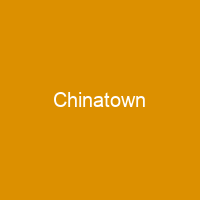Oxford Dictionaries defines it as a district of any non-Asian town, especially a city or seaport, in which the population is predominantly of Chinese origin. Some Chinatowns are in fact pan-Asian, meaning they could also be counted as a Koreatown or Little India. Emigration to other parts of the world from China accelerated in the 1860s.
About Chinatown in brief

The term has been used to refer to areas of Chinatowns across the world, including Europe, North America, South America, Asia, Africa, Australasia and the Middle East. It can also refer to Chinese ethnoburbs which by definition are suburban ethnic clusters of residential areas and business districts in large metropolitan areas where the intended purpose is to be as isolated from the white population as Hispanics. This contrasts with narrower definitions, where the term only described Chinatown in a city setting. Some of these Chinatowns may have little to do with China, such as Asiatown in Cleveland, Ohio, which acts as a unifying factor for the Chinese, Taiwanese, Korean, Japanese, Filipino, Indian, Vietnamese, Cambodian, Laotian, Nepalese and Thai communities of Cleveland. As net migration has slowed into them, the smaller Chinatowns have slowly decayed, often to the point of becoming purely historical and no longer serving as ethnic enclaves. A more modern example, in Montville, Connecticut, was caused by the displacement of Chinese workers in the Manhattan Chinatown following the September 11th attacks in 2001. It was initially referred to as a Chinatown but was subsequently renamed due to the influx of non-Chinese Asian Americans who opened businesses there.
You want to know more about Chinatown?
This page is based on the article Chinatown published in Wikipedia (as of Feb. 10, 2021) and was automatically summarized using artificial intelligence.







